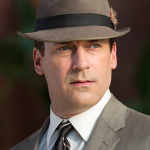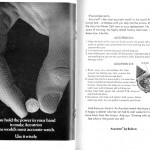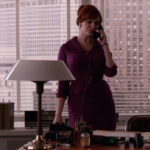Last season’s finale closed out 1968 with just about everyone on Mad Men dealing with circumstances beyond their control and standing on the doorstep of change. On his way out the door to take his forced leave of absence, Don bumped into Duck Phillips with Lou Avery, his replacement. Ouch! Pete and Ted were headed out to set up SC&P West and Megan was also packed and ready to go. Peggy was stepping into more responsibility and Joan was stepping up her game.
 This season’s premiere episode, “Time Zones,” picks up eight weeks later in January 1969 with the main characters feeling their way through uncertainties and altered life states. Don continues to be in a state of denial about his exile from SC&P and his marriage. Peggy is struggling with Ted’s rejection, the absence of Don, and working for a wimpy creative director, Lou Avery. Pete and Ken seem to have traded personas and are living in alternate realities. The unflappable Ken is buckling under the pressure of his expanded responsibilities (and still wearing an eye patch), and the usually tight assed Pete is thoroughly enjoying his new laid back LA life style. Who would have ever imagined seeing Pete completely relaxed around Don while they enjoy a pastrami sandwich at Canter’s deli in LA. Ted, on the other hand, is keeping a very low profile on both coasts, while Roger is totally embracing the free love culture of the moment and Bob Benson is keeping the wheels on Chevy in Detroit. Joan is still fighting for the recognition and respect she deserves and clearly emerges as the strength of the agency in this episode. Joan’s confidence is building as she takes charge of a potentially damaging development with SC&P’s Butler Shoe client.
This season’s premiere episode, “Time Zones,” picks up eight weeks later in January 1969 with the main characters feeling their way through uncertainties and altered life states. Don continues to be in a state of denial about his exile from SC&P and his marriage. Peggy is struggling with Ted’s rejection, the absence of Don, and working for a wimpy creative director, Lou Avery. Pete and Ken seem to have traded personas and are living in alternate realities. The unflappable Ken is buckling under the pressure of his expanded responsibilities (and still wearing an eye patch), and the usually tight assed Pete is thoroughly enjoying his new laid back LA life style. Who would have ever imagined seeing Pete completely relaxed around Don while they enjoy a pastrami sandwich at Canter’s deli in LA. Ted, on the other hand, is keeping a very low profile on both coasts, while Roger is totally embracing the free love culture of the moment and Bob Benson is keeping the wheels on Chevy in Detroit. Joan is still fighting for the recognition and respect she deserves and clearly emerges as the strength of the agency in this episode. Joan’s confidence is building as she takes charge of a potentially damaging development with SC&P’s Butler Shoe client.
Don’s Presence And Pretense
The episode opens at the agency with Freddy Rumsen, now working as a freelance copywriter, mesmerizing Peggy with his campaign pitch for Accutron watches. You could almost sense that Peggy feels like she is listening to her old boss Don. We find out later that she actually was. Don is serving as Freddy’s covert creative partner and Freddy is delivering the pitch that Don wrote. On Madison Avenue, Don has slipped from the pedestal of star creative director to a behind the scenes copywriter, but he still has his creative moments. Don’s Accutron pitch is reminiscent of his emotional Kodak Carousel speech.“Accutron. It’s not a timepiece. It’s a conversation piece.” Peggy calls it “a home run” but she can’t resist the urge to suggest an alternate line: “Accutron. It’s time for a conversation.” Accutron was a revolutionary timepiece introduced by Bulova in 1960. It was manufactured in Switzerland and used a tuning fork as its mechanism. In fact, Accutron’s 1969 advertising campaign was far less emotional than Don’s vision and focused on its being the most accurate timepiece available.
out later that she actually was. Don is serving as Freddy’s covert creative partner and Freddy is delivering the pitch that Don wrote. On Madison Avenue, Don has slipped from the pedestal of star creative director to a behind the scenes copywriter, but he still has his creative moments. Don’s Accutron pitch is reminiscent of his emotional Kodak Carousel speech.“Accutron. It’s not a timepiece. It’s a conversation piece.” Peggy calls it “a home run” but she can’t resist the urge to suggest an alternate line: “Accutron. It’s time for a conversation.” Accutron was a revolutionary timepiece introduced by Bulova in 1960. It was manufactured in Switzerland and used a tuning fork as its mechanism. In fact, Accutron’s 1969 advertising campaign was far less emotional than Don’s vision and focused on its being the most accurate timepiece available.
Using freelance creative talent to fill in on special projects was and still is common practice at agencies. Creative directors like Peggy always had a small pool of trusted people they could call on. For Peggy it was a way to help out her old friend Freddy, and for Don, it served as a way to keep his invisible hand in the agency’s creative work and ease his denial about being “out” at SC&P.
The late sixties ushered in some fundamental changes to the economics of the ad agency business that would alter its core business model. As media budgets rose, clients were paying more attention to the amount of money flowing into their ad agencies. The high flying days of the 15% media commission system that guaranteed big income and cash flow for agencies was slowly giving way to a fee based compensation system. The fee-based system places greater control and scrutiny of agency costs in the hands of the client and requires much tighter management of people and expenses by agencies.
SC&P’s client, Butler Shoes, new MBA marketing director, Wayne Barnes, is reflective of this change. Eager to put his fiscal management skills to work, Wayne confronts Joan with his decision to go “in-house” with their advertising. When Joan tries to dissuade Wayne, he dismisses her saying “This conversation is best for Ken.” Joan gets him to hold off on the recommendation until she has a chance to speak with Ken. By going in-house, Butler would place their own media and receive the 15% commission previously paid to the agency. Butler could use those funds to build their in house advertising department, hire freelance creative teams, and most likely reduce their advertising costs.
 Joan is determined to stop this and finds a professor to give her a crash-course on marketing in return for Joan’s educating him about the new agency compensation models he’s been hearing about. Joan rises to the occasion and proceeds to educate the professor telling him that he will need a bigger note pad. On a side note Joan mentions that SC&P’s clients are split 50/50 commission versus fees. In fact, at that time, the great majority of clients still employed the commission-based system and it would take a number of years to reach the 50/50 level. Today, virtually all clients use fee-based compensation systems. Back at the agency, Ken’s secretary Clara tells Joan that Mr. Butler will be coming to the agency that week. A very upset Joan calls Wayne and pins his MBA butt to the wall by talking marketing strategy like a seasoned pro and warning him about the perils of buying media in-house. “You will be competing against us, not against other shoe companies.” Wayne backs off and agrees to tell his boss that SC&P cancelled the meeting because the agency needed more time to revise their strategy. This is a temporary victory for Joan and another point of frustration for an already frazzled Ken. It will be interesting to see how the next Wayne and Joan encounter develops. I’m betting on Joan.
Joan is determined to stop this and finds a professor to give her a crash-course on marketing in return for Joan’s educating him about the new agency compensation models he’s been hearing about. Joan rises to the occasion and proceeds to educate the professor telling him that he will need a bigger note pad. On a side note Joan mentions that SC&P’s clients are split 50/50 commission versus fees. In fact, at that time, the great majority of clients still employed the commission-based system and it would take a number of years to reach the 50/50 level. Today, virtually all clients use fee-based compensation systems. Back at the agency, Ken’s secretary Clara tells Joan that Mr. Butler will be coming to the agency that week. A very upset Joan calls Wayne and pins his MBA butt to the wall by talking marketing strategy like a seasoned pro and warning him about the perils of buying media in-house. “You will be competing against us, not against other shoe companies.” Wayne backs off and agrees to tell his boss that SC&P cancelled the meeting because the agency needed more time to revise their strategy. This is a temporary victory for Joan and another point of frustration for an already frazzled Ken. It will be interesting to see how the next Wayne and Joan encounter develops. I’m betting on Joan.
Peggy Pushes For Creative Excellence
 On the other side of the office, Peggy is dealing with her own set of issues and rejections. She presents her version of the Accutron campaign to Lou and is flatly rejected. Lou Avery is a far cry from Don and Ted. Lou calls his creative department meetings “check ups.” It’s clear that Peggy and the creative teams feel like they are in a doctor’s office and the creative sparks are missing. After being rejected once, Peggy approaches Lou about Accutron: “I realized Freddie’s original idea was the best, but I didn’t do it justice.” Lou dismisses her again saying he already agreed to a different concept. Peggy vents her frustration with Lou to Stan who tells her to let it go. An exhausted and demoralized Peggy yells back, “Nobody cares about anything!” It’s clear to her that SC&P is in danger of loosing its creative mojo. Later Peggy is alone crying on the floor of her apartment questioning her circumstances and own self worth. Peggy will again be put to the test if and when she discovers that Don is the ghost copywriter behind Freddy’s flashes of brilliance.
On the other side of the office, Peggy is dealing with her own set of issues and rejections. She presents her version of the Accutron campaign to Lou and is flatly rejected. Lou Avery is a far cry from Don and Ted. Lou calls his creative department meetings “check ups.” It’s clear that Peggy and the creative teams feel like they are in a doctor’s office and the creative sparks are missing. After being rejected once, Peggy approaches Lou about Accutron: “I realized Freddie’s original idea was the best, but I didn’t do it justice.” Lou dismisses her again saying he already agreed to a different concept. Peggy vents her frustration with Lou to Stan who tells her to let it go. An exhausted and demoralized Peggy yells back, “Nobody cares about anything!” It’s clear to her that SC&P is in danger of loosing its creative mojo. Later Peggy is alone crying on the floor of her apartment questioning her circumstances and own self worth. Peggy will again be put to the test if and when she discovers that Don is the ghost copywriter behind Freddy’s flashes of brilliance.
While Don may have hit bottom professionally and pretending to still be working at SC&P, it does appear as if he’s drinking less and can actually control his reflex reaction to hop in bed with any ready and willing conquest. Whether this is enough to regain Megan’s trust and earn an invitation back to his corner office at SC&P remains to be seen. The episodes closes with Don out in the cold on his balcony with Vanilla Fudge’s cover of The Supreme’s “You Keep Me Hangin’ On” on the soundtrack. For now, it seems like hanging on is good enough for Don.
